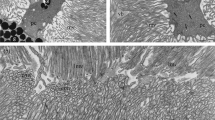Abstract
Retinal proteins were labeled by intraocular injections of radioactive amino acids. Tissue slices of the superior colliculus (SC) were prepared 18–20 hr later, i.e., when the rapid phases of the axonal transport had reached the SC terminals. The effect of depolarizing pulses of high K and of Ca withdrawal on the secretion of radioactivity was studied in a perfusion system. The effluents were separated into a trichloroacetic acid (TCA) precipitable fraction and a TCA-soluble fraction. High K evoked a release of TCA-soluble radioactivity when [3H]glycine, [3H]leucine, or [3H]proline were used as protein precursors. Small changes occurred for TCA-precipitable fractions. The evoked release of radioactivity was Ca dependent and particularly prominent after labeling with [3H]glycine. Ca withdrawal increased the efflux of exogenous GABA, primary amines, and TCA-precipitable radioactivity but not of TCA-soluble radioactivity when normal media were used. The formation of TCA-soluble radioactivity was measured by incubating combined homogenates of SC and the lateral geniculate body (LGB), containing labeled proteins transported by the slow or rapid phase. The proteolytic activity was highly Ca dependent, for the rapidly transported proteins the half maximum was at ∼0.1 mM Ca. The formation of TCA-soluble radioactivity was inhibited byp-chloromercuriphenylsulfonic acid (PCMS). Other divalent cations could not substitute for Ca. The rate of formation of TCA-soluble radioactivity and the influence of Ca ions was smaller when proteins of the slow phase were used as substrate.
Similar content being viewed by others
References
Boadle-Biber, M. C. 1979. Activation of tryptophan hydroxylase from slices of rat brain incubated with agents which promote calcium uptake or intraneural release. Biochem. Phamacol. 28:2129–2138.
Boadle-Biber, M. C. 1979. Decrease in the activity of tryptophan hydroxylase from slices of rat brain stem incubated in a low calcium or a calcium-free manganese-substituted medium. Biochem. Pharmacol. 28:3487–3490.
Guroff, G. 1964. A neutral, calcium-activated proteinase from the soluble fraction of the rat brain. J. Biol. Chem. 239:149–155.
Hoffman, P. N. andLasek, R. I.. 1975. The slow component of axonal transport. Identification of major structural polypeptides of the axon and their generality among mammalian neurons. J. Cell Biol. 66:351–366.
Karlsson, J.-O. 1977. Is there an axonal transport of amino acids? J. Neurochem. 29:615–617.
Karlsson, J.-O., andSjöstrand, J. 1971). Synthesis, migration and turnover of protein in retinal ganglion cells. J. Neurochem. 18:749–767.
Karlsson, J.-O., andSjöstrand, J. 1971. Transport of microtubular protein in axons of retinal ganglion cells. J. Neurochem. 18:975–982.
Karlsson, J.-O., andSjöstrand, J. 1972. Axonal transport of proteins in retinal ganglion cells. Characterization of the transport to the superior colliculus. Brain Res. 47:185–194.
Kelly, R. B., Deutsch, I. W., Carlsson, S. S., andWagner, I. A. 1979. Biochemistry of neurotransmitter release. Annu. Rev. Neurosci. 2:399–446.
Marks, N., Datta, R. K., andLajtha, A. 1970. Distribution of amino acids and of exo- and endopeptidases along vertebrate and invertebrate nerves. J. Neurochem. 17:53–63.
Orrego, F. 1971. Protein degradation in squid giant axons. J. Neurochem. 18:2249–2254.
Pant, H. C., Terakawa, S., andGainer, H. 1979. A calcium-activated protease in squid axoplasm. J. Neurochem. 32:99–102.
Peters, A., Palay, S. L., andWebster, H. 1976. The synapses. Pages 118–180,in Peters, A., Palay, S. L., andWebster, H. (eds.), The fine structure of the nervous system: The neurons and supporting cells. W. B. Saunders, Philadelphia.
Potashner, S. I. 1978. Effects of tetrodotoxin, calcium and magnesium on the release of amino acids from slices of guinea-pig cerebral cortex. J. Neurochem. 31:187–195.
Sandberg, M., Hamberger, A., Karlsson, J.-O., andTirillini, B. 1980. Potassium-stimulated release of axonally transported radioactivity from slices of rabbit superior colliculus. Brain Res. 188:175–183.
Sandoval, I. V., andWeber, K. 1978. Calcium-induced inactivation of microtubule formation in brain extracts. Eur. J. Biochem. 92:463–470.
Willard, M., Wiseman, M., Levine, I., andSkene, P. 1979. Axonal transport of actin in rabbit retinal ganglion cells. J. Cell Biol. 81:581–591.
Author information
Authors and Affiliations
Rights and permissions
About this article
Cite this article
Sandberg, M., Hamberger, A., Jacobson, I. et al. Role of calcium ions in the formation and release of low-molecular-weight substances from optic nerve terminals. Neurochem Res 5, 1185–1198 (1980). https://doi.org/10.1007/BF00964898
Accepted:
Issue Date:
DOI: https://doi.org/10.1007/BF00964898



